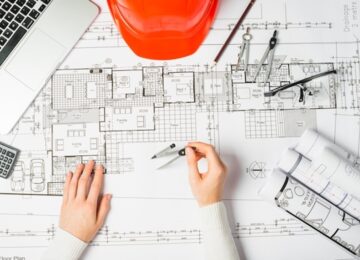Factory architects are instrumental in creating industrial spaces that enhance workflow and productivity. By blending innovative design principles with a deep understanding of industrial operations, they ensure that facilities meet current and future demands.
-
Strategic Space Planning
Efficient workflow starts with effective space utilization.
- Zoning Layouts: Dedicated areas for production, storage, and administrative functions streamline processes.
- Optimized Traffic Flow: Minimizing bottlenecks by designing clear pathways for workers and equipment.
- Scalable Spaces: Flexible layouts that accommodate changes in production demands.
Strategic planning ensures seamless operations across all departments.
-
Workflow Automation Integration
Modern factories rely heavily on automation for efficiency.
- Robotics-Friendly Design: Open floor plans and precise infrastructure placement support automated systems.
- IoT Connectivity: Integrated networks for real-time monitoring and machine communication.
- Energy-Efficient Systems: Use of smart technologies to optimize energy use and reduce operational costs.
Architectural designs that prioritize automation increase productivity and reduce errors.
-
Enhancing Worker Efficiency
Designing with employees in mind fosters productivity.
- Ergonomic Workstations: Reducing strain and fatigue for workers.
- Natural Lighting: Improves focus and mood, leading to better performance.
- Break Areas: Comfortable and accessible spaces for rest enhance employee satisfaction.
A worker-focused design promotes both morale and efficiency.
-
Streamlined Material Handling
Efficient material flow is critical in industrial settings.
- Direct Pathways: Designs minimize the distance materials travel during production.
- Storage Optimization: Proper placement of raw materials and finished goods to reduce handling times.
- Dock Access: Easy loading and unloading areas to improve logistics.
Streamlined handling reduces delays and operational costs.
-
Safety Enhancements for Productivity
Safe environments lead to uninterrupted workflows.
- Emergency Protocols: Clearly marked exits and accessible fire suppression systems.
- Hazard Mitigation: Separation of high-risk areas to protect workers.
- Ventilation Systems: Ensures clean air and reduces health risks in chemical-heavy industries.
Safety-focused designs minimize accidents, downtime, and liability concerns.
-
Future-Proof Design Solutions
Architects ensure facilities remain efficient as needs evolve.
- Modular Infrastructure: Allows easy adaptation for new machinery or processes.
- Sustainability Features: Reduces costs while meeting environmental standards.
- Technological Upgrades: Space for integrating future advancements in production technology.
Future-ready factories maintain efficiency in dynamic industries.
Conclusion
Factory architects play a crucial role in improving workflow and productivity by integrating technology, safety, and human-centric designs. With expertise from Usine architects Stendel + Reich, businesses can maximize operational efficiency while preparing for future growth.








